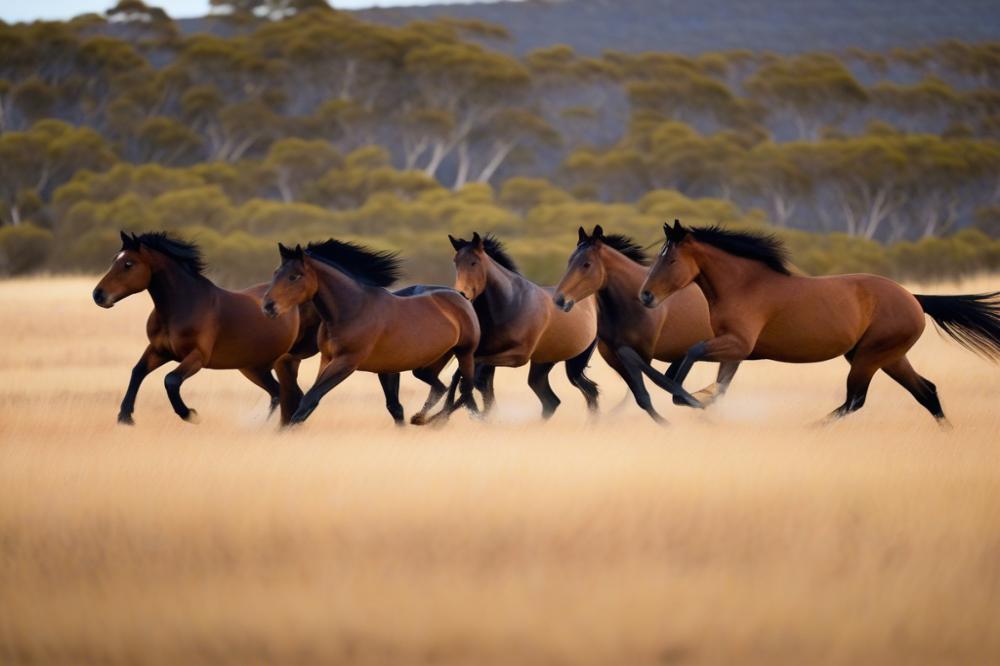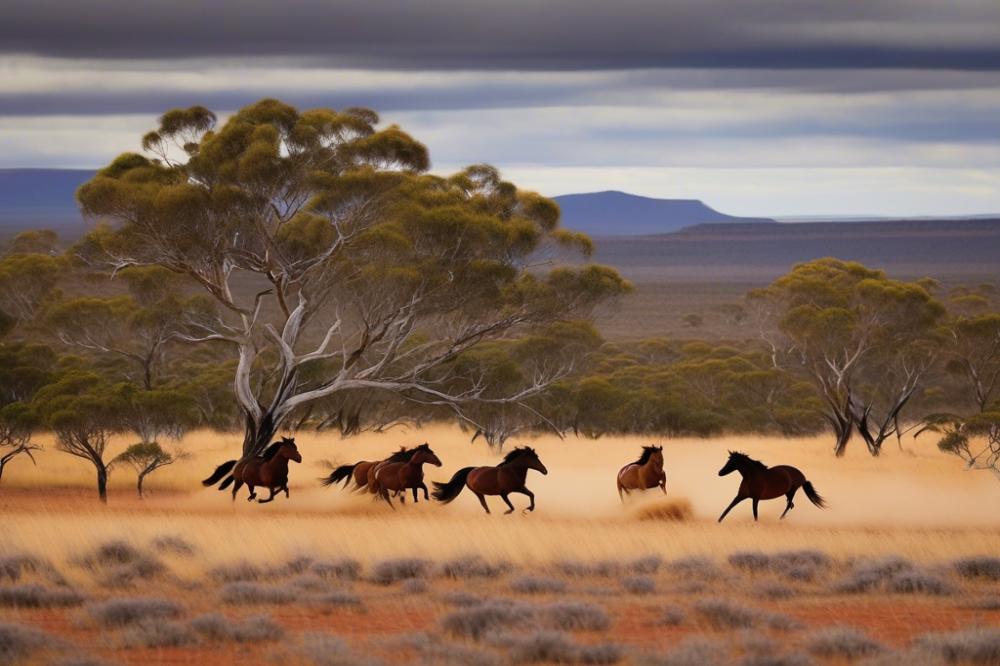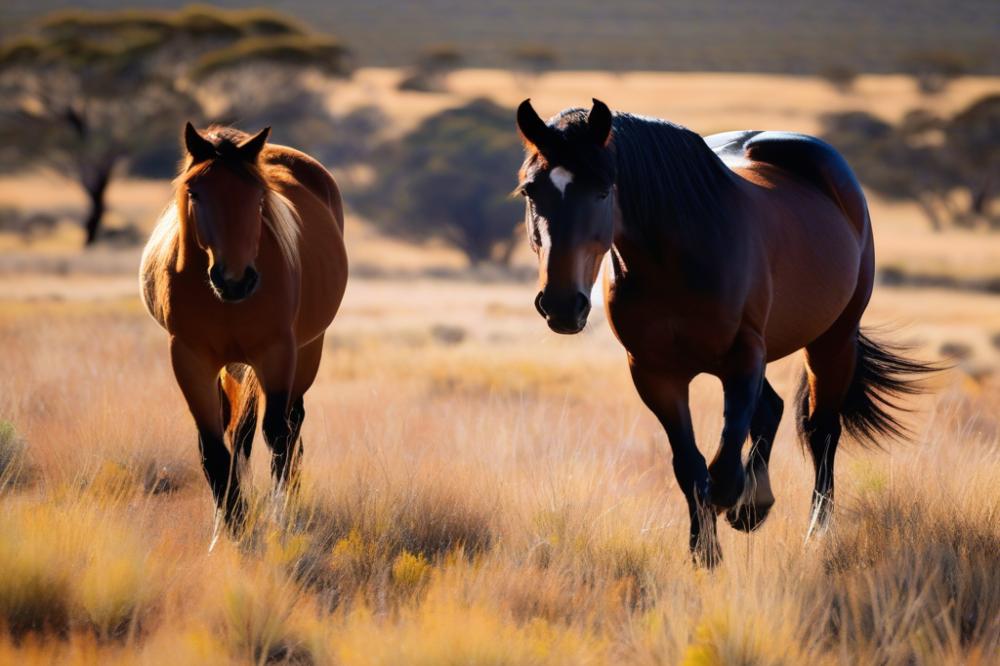Exploring Australia‘s Brumbies
The Brumbies are a fascinating part of Australia’s wildlife. These feral horses roam freely across the vast outback, making them a significant part of the landscape. Over time, their population has grown to be the largest of its kind in the world. This impressive number highlights their unique position within the global ecosystem.
In a global context, the presence of these horses raises important questions. How do feral animals affect the environment? What role do they play in Australian culture? Understanding their impact requires a closer look at various themes, including ecology and management practices.
Caring for the ecology is essential as these horses can cause both harm and benefits to native flora and fauna. Management of their populations is necessary to maintain a balance that protects other species. Culturally, Brumbies hold a special place in the hearts of many Australians, often symbolizing freedom and ruggedness. This connection to national identity complicates how society views them.
Overall, the story of these feral horses is one of beauty, conflict, and adaptation. As we delve deeper into this topic, the complexities surrounding their existence will become clearer. Understanding their significance goes beyond mere numbers; it is about the relationships between nature, culture, and management.
Understanding Brumbies

Feral horses in Australia are known as Brumbies. They represent one of the largest wild horse populations globally. These animals exhibit a variety of physical traits. Typically, they have sturdy bodies, strong legs, and thick manes. Coat colors can vary significantly, including black, brown, bay, and grey. Their adaptability sets them apart from domesticated horses. They thrive in diverse climates, from arid regions to lush forests.
The history of feral horses in Australia dates back to the early European settlement. In the 18th century, settlers brought horses for agricultural purposes and transportation. Some animals escaped or were released, leading to the establishment of wild populations. Over time, these horses adapted to their new environment. They foraged for food and water, often in harsh conditions. By the 20th century, Brumbies had become a common sight in various landscapes across the continent.
Understanding the origins of the Brumby population reveals a complex mix. Different breeds contributed to their genetic makeup. While some ancestry can be traced to English and Irish horses, others include Spanish and Arabian influences. These breeds brought various traits, creating a heterogeneous population. Some horses exhibit strength and endurance, while others showcase agility. This blend allows them to navigate Australia’s rugged terrain effectively.
Many people cherish these wild horses, seeing them as symbols of Australia’s rich history. Yet, others view them as pests that disrupt native ecosystems. Managing their population remains a significant challenge. Balancing their presence with environmental preservation often sparks heated debate among communities. As the discussion continues, the role of feral horses in Australian culture remains prominent.
Ecology and Biodiversity

Role of Brumbies in the Australian Ecosystem
Feral horses play a significant part in the Australian landscape. They roam freely across various terrains, from grassy plains to rugged hills. Their movement helps in seed dispersal, which can support certain plant species. Grazing habits of these horses can also shape the vegetation. While they consume grass, they prevent it from becoming overly dense. This grazing can create openings for other plants to thrive.
Impact on Native Species and Biodiversity
However, these feral horses do not only have positive effects. Competition for food and water can hurt native species. Many smaller animals struggle to survive when resources become limited. Damage to vegetation can lead to soil erosion, affecting the entire ecosystem. Some plants that rely on specific conditions may decline. This decline impacts the animal species that depend on them. Overall, the intricate balance of the ecosystem is at risk.
The Balance Between Feral Populations and Conservation Efforts
Managing feral populations is a complex issue. Some believe they contribute to Australia’s heritage. Others argue that they harm biodiversity. Conservation efforts often aim to control numbers while protecting native wildlife. Techniques for population control vary. Culling, trapping, and relocation are commonly used methods. Each approach sparks debate about ethics and effectiveness. Finding common ground is necessary for both heritage and conservation goals.
Wildlife Conservation and Management
The management of feral horses in Australia presents a complex situation. Current practices aim to control their populations. Strategies include mustering, trapping, and translocation to other areas. Some methods focus on fertility control as well. While these approaches help, they are not without controversy.
Balancing the needs of native habitats with horse populations is a significant challenge. Feral horses compete for resources, often damaging the land. They can trample delicate vegetation and disrupt the habitats of other species. Protecting these ecosystems requires careful planning and collaboration among stakeholders.
Local communities, conservationists, and government agencies often disagree on the best practices. Many people appreciate the cultural value of the horses, while others emphasize ecological health. Finding common ground between these viewpoints is crucial. Open discussions may lead to more effective solutions.
Though there are various management strategies in place, success has been mixed. Certain areas have seen some improvement, while others remain difficult. Ongoing monitoring and adaptive management are essential for determining what works. Learning from each situation can help refine strategies moving forward.
Each step taken in managing feral horses must consider both the animals and the environment. Thoughtful approaches can pave the way for coexistence. In this intricate web of life, every decision has lasting effects. Balancing conservation with public interest requires ongoing effort and dedication.
Cultural Significance
In rural Australia, these feral horses hold a deep cultural significance. Many local legends have formed over the years, often celebrating the spirit and resilience of these animals. Farmers and stockmen have passed down stories featuring wild herds galloping across the plains. Their presence evokes a sense of adventure and ruggedness, embodying a piece of the Australian identity.
Artists and writers have frequently turned to these creatures for inspiration. Paintings portray their majestic forms against vast landscapes, capturing the essence of the bush. In literature, they often symbolize freedom and untamed nature. Authors delight in using them as metaphors for the wild heart of Australia. The imagery is powerful and resonates with many, stirring emotions tied to the land.
Public perception of feral horses varies widely. Some view them as iconic symbols of Australian heritage. Others see them as invasive pests damaging the environment. Debates surrounding their management spark strong feelings. On one hand, enthusiasts advocate for their preservation and celebrate their historical role. On the other hand, conservationists argue about the ecological impact of their numbers. Engaging in these discussions is essential for the future of wild horse populations.
Mustering Practices
Mustering refers to the gathering of wild horses, a significant practice in managing Australia’s feral horse population. Traditional techniques often involve horseback riders, dogs, and the use of natural terrain. Skilled riders know how to navigate different landscapes, guiding the animals effectively. These methods have been passed down through generations. They often emphasize teamwork and a deep understanding of animal behavior.
Modern mustering techniques have evolved over time. Some landowners now utilize drones and helicopters to locate and gather the horses. Technology allows for quicker and more efficient mustering. However, many still appreciate the old ways, believing they have a value that modern methods lack. Each approach serves its purpose in maintaining horse populations in the wild.
The role of mustering goes beyond simply gathering horses. It plays a crucial part in population management, helping to control numbers and reduce overgrazing in sensitive environments. Too many horses can strain resources. By carefully monitoring herd sizes, land managers protect the ecosystems. This balance is vital for both the horses and the land on which they roam.
Local communities often feel the impact of mustering activities. It creates jobs and supports livelihoods for many in rural areas. From ranchers to those involved in tourism, mustering can drive economic growth. Some visitors come to see the mustering process, attracted by its connection to the region’s culture. This influx of tourism can be beneficial for local businesses.
In summary, ranging from traditional techniques to modern technology, mustering plays a vital role in managing feral horse populations in Australia. The practice also affects the local economy, creating jobs and attracting tourism. It remains an important aspect of rural life, helping communities thrive.
Final Thoughts on Australia’s Feral Horse Population
In summary, Australia’s feral horse population presents a complex challenge. These horses have become a part of the landscape and hold cultural significance for many. However, their growing numbers lead to serious ecological impacts. Land degradation, water source depletion, and harm to native species are pressing concerns. Balancing these factors is critical for the health of Australia’s ecosystems.
Management strategies must reflect the needs of both the environment and communities. There is a pressing need for collaboration among stakeholders. These include Indigenous groups, conservationists, and local residents. By bringing various perspectives to the table, more effective solutions may emerge that respect both nature and heritage.
Future planning must carefully consider ecological and cultural aspects. The legacy of these horses encompasses more than mere numbers. It embodies a story of survival and adaptation. Conservation efforts should not overlook the historical ties people have with these animals. A nuanced approach can lead to a sustainable outcome.
In closing, addressing this issue requires awareness and action. A concerted effort among all involved can aid in creating a balance that benefits both wildlife and human interests. As discussions evolve, let’s prioritize both the ecological integrity of Australia and our unique cultural connections to the land and its feral inhabitants.



